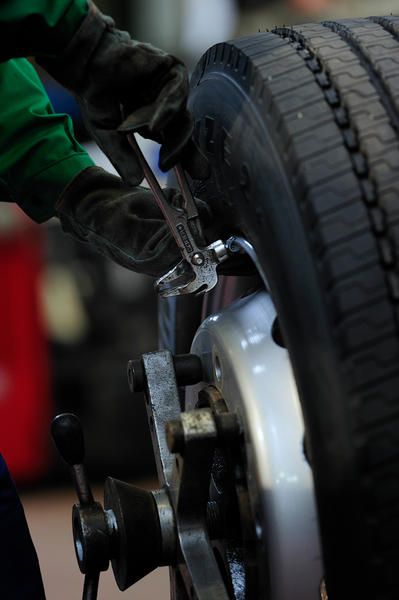Fitting
Correct fitting, performed in accordance with recommended operating procedures and complying with the safety rules in force, ensures excellent protection for people and material, and allows the tyres full potential to be exploited.
Poor fitting or non-respect of recommended practice can cause damage to the tyres, the vehicle or to people (serious, even fatal injuries).
It is therefore essential that these operations are carried out in a tyre shop by people who have been trained and who have the appropriate equipment available.
General precautions
If a trainee carries out any part of the tyre fitting procedure, he/she must always be closely supervised by a qualified tyre professional.
In all cases, it is essential to refer to the technical instructions of the tyre manufacturer, vehicle manufacturer and wheel manufacturer, as well as the user manual for the tyre-fitting machinery or equipment.
Operators must:
Always wear their normal protective clothing (gloves, safety shoes etc.)
Must have access to an operating procedure.
Ensure that the vehicle engine is switched off and that the vehicle is properly stabilised (handbrake, blocks, supports, etc.).
Precautions for removing the wheel from the vehicle
In the case of dual (twinned) fitments or if the rim shows evidence of damage, the tyres must be deflated before removal of the fitment assembly.
Ensure that the wheel and tyre are cool enough to allow safe removal.
Comply with the manufacturer’s recommendations and instructions.

Precautions for fitting
Check that the tyre and wheel are of the correct dimensions, are compatible with each other and are compatible with the vehicle's conditions of use.
Check that the tyre, the wheel and its components are in good condition and suitable for service before fitting.
Respect any fitting instructions on the tyre sidewalls (fitting orientation or direction of rotation for example) and ensure the tyres are fitted to the correct positions on the vehicle.
Rubber valves must be systematically replaced in tubeless applications.
Metallic valves must be checked for condition and air tightness. Replace the valve or seals where necessary.
After fitting the assembly to the vehicle, it is important to use a suitable calibrated torque wrench and installation method to tighten the nuts to the torque specified by the vehicle manufacturer.
Precautions for inflation
Correct tyre inflation is an essential factor, not only for optimal tyre performance but also for SAFETY.
It is necessary for correct vehicle handling (road holding and braking) as well as for maintaining tyre condition.
Only use inflation equipment intended for this purpose and fitted with a pressure limiter. In no event must a person or operator be in the immediate proximity of the equipment in order to be out of the path of any potential discharge in the event of an incident.
Tyre operating inflation pressure
Comply with the tyre inflation pressures recommended by the vehicle manufacturer. These can be found:
On the vehicle itself – on the door, door frame, fuel filler cap, etc... or
In the vehicle user manual, or handbook, or if not, refer to the tyre manufacturer’s recommendations or professional guide.
Under-inflation or excessive over-inflation can significantly alter the vehicle’s handling and tyre performances.

Balancing
If the fitted assembly is not correctly balanced (dynamically), it may induce vibrations into the vehicle during service.
It is therefore essential to balance all four wheels for a comfortable drive and for sustained vehicle and tyre performance.
For effective wheel balancing, the balancing machine must:
Have a centring system matching that used on the vehicle hub,
Be calibrated in accordance with the manufacturer’s instructions.
These two points are critical to the quality of the work carried out, and are often at the root of faulty balancing.
Lack of or faulty balancing manifests itself in the form of vibrations in the vehicle, within various speed ranges. It is therefore essential that these operations are carried out in a tyre shop, by people who have been trained and who have the appropriate equipment available.
